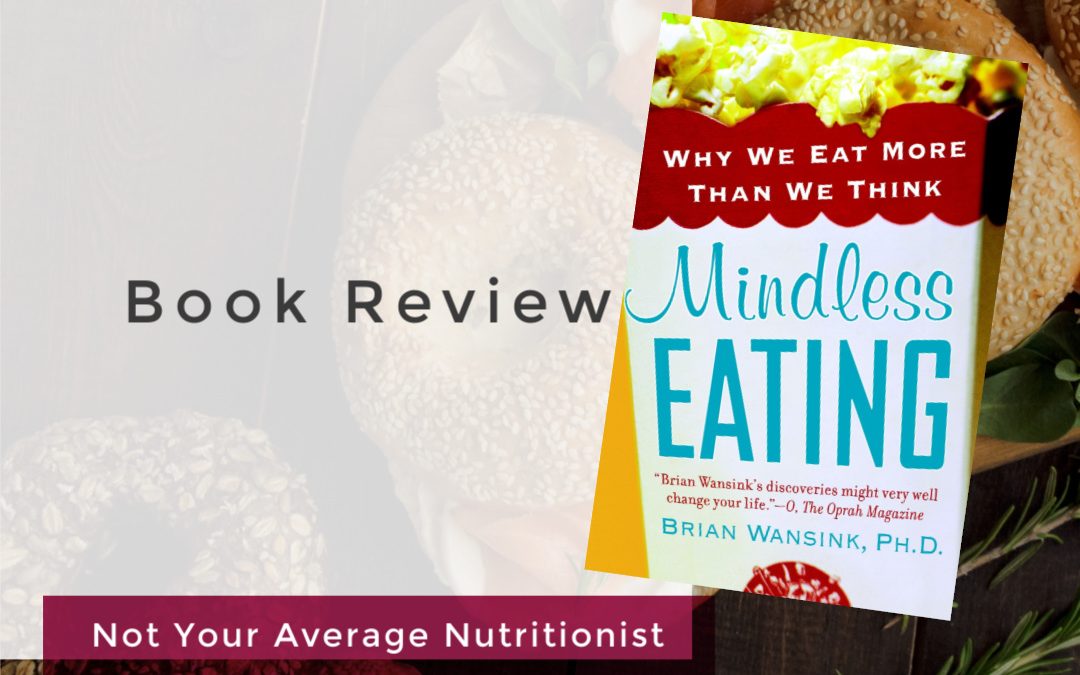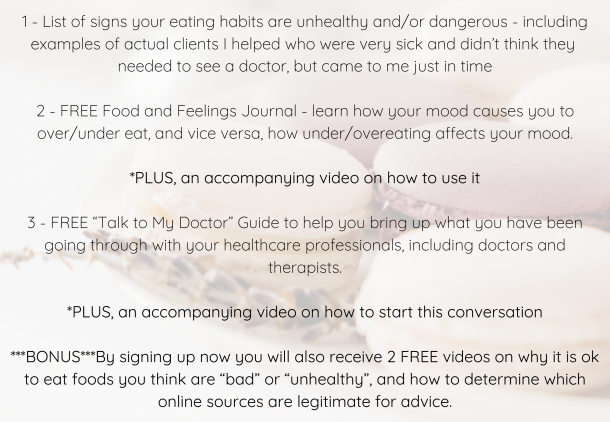This review was written for my college class “Psychology of Eating,” 2016.
Elizabeth Parker, MS, RD
About the author
Dr. Brian Wansink, who has been called the “Sherlock Homes of eating behavior,”1 founded the Food and Brand Lab at Cornell University in 1997. He was born in Iowa in 1960, and at the time of publication of this book (2007), he has created and lead over 250 studies in consumer behavior. Wansink has a PhD in Consumer Behavior from Stanford University, and has since taught marketing and consumer behavior at both Dartmouth and Cornell Universities. He is the recipient of numerous accolades including, “Humorous Ig Nobel Prize”, and was named “ABC World News Person of the Week” in January 20081. Current work includes, Executive Director of the USDA’s Center for Nutrition Policy and Promotion, promoter of the 2010 Dietary Guidelines, professor of Consumer Behavior at Cornell University, and most notably author of “Mindless Eating,” and Slim By Design.”1
Abstract
Mindless Eating aims to share with the American population exactly what is influencing our food choices and eating habits through explaining research on consumer behavior. Dr. Wansink and his team of researchers have completed hundreds of studies on why people eat what they eat, and what influences how much we eat. Using easy-to-read, and entertaining anecdotes of his studies, Wansink share tips and strategies for “mindlessly” changing our food environment to promote better health and weight loss, without deprivation.
Chapter-By-Chapter Synopsis and Main Messages of Mindless Eating2
Chapter 1, The Mindless Margin: Wansink’s studies showed that we have a “mindless margin”2 of approximately 100 Calories more or less from our calorie needs that we do not really notice, and can lead to weight loss or gain. To make this easier, Wansink suggests serving yourself 20% less of most foods (food that you want to cut back on), and 20% more fruits and veggies than you normally would have.
Chapter 2, The Forgotten Food: Seeing evidence of how much you are eating in real time (for instance, leaving the bones from chicken wings you have eaten on your plate, or wrappers from candies in front of you) you are far more likely to eat less than if there was no evidence of what you ate. Since we eat with our eyes first, having large volumes of food (regardless of calorie density) works. Our stomach really has only three settings: starving/ could eat more/ stuffed; so we use external cues to stop eating instead of relying on hunger.
Chapter 3, Surveying the Tablescape: The size of food packages (how we buy or store food) has a direct influence on how much people eat. The larger the container the larger the serving size. This directly impacts the waistline. We drink more from short, wide, beverage glasses, and eat more from larger diameter plates or bowls, and more from larger serving scoops. This chapter also discusses why restriction-diets, such as Atkins and grapefruit diets, work through limiting variety of food options, making dieting “mindless” through “sensory specific satiety.” More options = more consumption.
Chapter 4, The Hidden Persuaders Around Us: We tend to eat more of what we premeditate or see before eating. If we know a food is there, we will think about it and be more likely to eat a larger amount than if we just happen upon the food. This can be helpful for choosing more healthy foods. Wansink suggests setting a bowl of fruit out where it is easily seen, and you will eat more fruit. Proximity to food is another trap for eating more. If food is easy to get to we will eat more than if the food is farther away/ harder to get to. Chapter 4 explains why bulk shopping causes weight gain – having more of the same food at your disposal means you eat more to get to “the right number”2 of items in the pantry. We can counteract this by “hiding the extras” of multi-packs in an opaque container, another room, or adding any level of difficulty. Some other tips from this chapter: Make a shopping list, and eat before you shop.
Chapter 5, Mindless Eating Scripts: We have “scripts” or habits when it comes to how and when we eat. These can be situational (like eating by the time on the clock), or influenced by others (taking more food until everyone at the table has finished). Watch how much and how fast your dining companions eat – we are easily swayed by them! Multitasking while eating (say, watching TV, reading, or driving) distracts us from our food and will lead to more mindless munching than if we were not multi-tasking. The longer the “distraction,” the more we eat. Another influencer in how fast we eat is ambiance. Lighting, music, sound level and other mood-settings influence our pace and consumption of food. Similarly, the scent of food can draw us in to purchase/eat food that we had not planned on eating. Temperature and time of year also influence our eating habits. When it is getting colder/is cold, we eat and drink more to stay warm. When it is warm we move more and drink more water to stay cool.
Chapter 6, The Name Game: We taste what we expect – based on visual cues such as colors and descriptions, how appetizing the food looks (or does not), presentation (including what it is served on), as well as our other senses. We also associate brand name with superiority.
Chapter 7, In The Mood For Comfort Food: A study done in favorite “comfort foods” showed a marked difference in male and female choices. Males choose more “hot meal” foods (like pasta) that evoked feeling of being taken care of, and females choose more “snacklike foods”2 like chocolate, not because they do not like the food the men mentioned, but because those foods made them think of the work of making the meal. Comfort foods tend to be associated with specific happy memories or traditions that supply positive emotions. In the same way, negative associations can cause dislike for foods. We also choose foods based on personality, as this chapter explains. Competition for food (knowing whether or not it will still be there later) influences our decision to “eat the best first, or save the best for last.”2 Youngest children or those from large families, thus set themselves up to eat the more calorically dense parts of the meal first (as opposed to veggies/ salad) and are more likely to gain weight.
Chapter 8, Nutritional Gatekeepers: Nutritional gatekeepers are the person(s) in the household that makes and buys most of the food – and they have the most influence over what we eat. Most often, those with “good cooks” in the house ate, and liked, more vegetables. This is due to veggies taking more work to prepare, and thus need a “cook.” Parents and caretakers influence children’s food preferences from very early on. Children are able to recognize facial expressions of love and disgust, and notice what the person making the face is eating. They use these associations to decide how they will feel about the food when offered it, and future behaviors around foods. Additionally, using creative names and associations for commonly disliked foods, increased children’s consumption when labeled “dinosaur trees,” as opposed to “broccoli.”
Chapter 9, Fast Food Fever: We are designed to seek out “safe foods” that have salt, sugar, and/or fat. It is no coincidence that restaurants, food companies, and even home chefs add these ingredients to food when they want diners to eat. Much of this chapter focuses on marketing and packaging done by food companies. Restaurants also use “health halos” to make us believe that, because they advertise healthy options, that all of their menu items are lower-calorie. By doing this the average diner is likely to add on sides, drinks, or dessert, because they thought they had eaten a “healthier” main dish. Low-fat options also have this health halo effect, and cause many to eat more calories than if they had been told it was the regular fat version. Another factor in how much we eat is the “serving” we are eating from. Where is the natural stopping point- with a single-serve package, or one “sleeve” of cookies? We are influenced by where there are built-in stopping points.
Chapter 10, Mindlessly Eating Better: Fighting an obesogenic culture is not about making huge changes, but eating “better” with do-able “mindless” strategies, laid out in chapter 10. Here Wansink gives strategies including, “food trade-offs,” “food policies,” and “the power of three [behavior changes].”2 These strategies are explained to help us break habits and, in an achievable way, mindlessly eat a little better.
Appendix A: Description, advantages, and disadvantages of popular diets (including this book).
Appendix B: Quick tips for “dieting danger zones”2.
Frequently Asked Questions.
The intended audience for this book is anyone who eats. We make hundreds of food options every day, so there is no one who would not find at least a small tidbit of helpful knowledge from this book. The main aim of book is to educate consumers on simple ways to make eating smarter easier.
Commentary & Evaluation
I enjoyed reading the quick, to-the-point, research abstracts throughout the book. The use of psychology in the explanations of study findings was especially informative, for example, how males and females chose different types of comfort foods based on what made them feel “pampered”2. Each chapter made specific points and ended with strategies, influenced by the studies discussed, for the reader to use; this dispelled the myth that you “can’t teach an old dog new tricks,” or an adult new eating habits.
Overall the strengths of the book included: easy to read format; promotion of slow, steady weight loss by changing just 100 Calories per day or ~10 lbs per year; simple tips to be more mindful of what you are eating and potential for weight loss; and solid research that is referenced in other periodicals, including Rowland and Splane’s Psychology of Eating.3 One example is the description of “sensory specific satiety” 2,3 referenced in both books, as well as our idea of what a portion size is, based on what is placed in front of us.3
Weaknesses of the book included: 3,500 Calories = 1 lb. Other research proves this is not necessarily true. Authors Herrin and Larkin make a specific point to show that “3,500 Calories = 1 pound myth”4. These eating disorder experts explain that mathematically 3,500 Calories seems correct, but taking into account body processes for making muscle, bone, and other tissues, 3,500 Calories is only an approximation, and not a hard rule of weight loss or gain.
Final Judgment
I would recommend this book for most people. Wansink’s tips are easy to follow, and his research study descriptions are eye-opening. As a Registered Dietitian, I have shared verbal synopsis of some of his research with clients I am counseling (for weight loss), that make them re-evaluate how they are choosing their food. Several clients have bought the book, themselves, and reported finding it fascinating and helpful in restructuring how they store and plate food. The only people I might not recommend this book to those suffering from anorexia nervosa. This is because the book is structured more for weight loss and maintenance, and eating more “healthy” foods, which could trigger someone who is restricting intake.
References
- Brian Wansink. Linked-In. https://www.linkedin.com/in/wansink. Accessed May 30, 2016.
- Wansink B. Mindless Eating: Why We Eat More than We Think. New York: Bantam Books; 2006.
- Rowland N, Splane EC. Psychology of Eating. Pearson Education, Inc.; 2014:37,68.
- Herrin, M, Larkin, M. Nutrition Counseling in the Treatment of Eating Disorders. 2nd ed. New York: Routledge; 2013:224.


